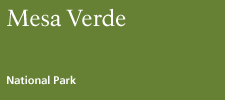
|
ANTIQUITIES OF THE MESA VERDE NATIONAL PARK
CLIFF PALACE
By JESSE WALTER FEWKES
GENERAL PLAN OF CLIFF PALACE
The ground plans of Cliff Palace which have been
published were made from surface indications before excavations were
undertaken and necessarily do not represent all the rooms.
Nordenskiöld's map outlines 17 kivas and 102 rooms, indicating several
kivas by dotted lines. The Morley-Kidder map, which represents positions
of 18 or 19 kivas, notes 105 secular rooms.b Although this ground
plan is an improvement on that of Nordenskiöld, it also was based on
surface indications and naturally fails to indicate those kivas that
were buried under the fallen walls of the terraces. Strangely enough, in
Nordenskiöld's ground plan Kiva K is omitted, notwithstanding the tops
of one or two pilasters were readily seen before any excavation was
made. Neither of these plans distinguishes those buildings that have
more than a single story, although they show the parts of walls that
extend to the roof. Neither Chapin nor Birdsall published maps of Cliff
Palace. (See pl. 8.)
bIn "Report, House of Representatives, No.
3703, 58th Congress," Mr. Coert Dubois ascribes to Cliff House (Cliff
Palace) 146 rooms and 5 estufas (kivas). Unfortunately the error in the
count of kivas has been given wide circulation. As stated in the present
article, there are at least 23 rooms in Cliff Palace that may be called
kivas.
TERRACES AND RETAINING WALLS
The terraces in front of the rooms occupying the
floor of the cave are characteristic features of Cliff Palace (pls. 9,
10). The excavations revealed three of these terraces, of which the
floor of the cave is the fourth. This fourth terrace, or cave floor, is
in the main horizontal, but on account of the accumulated talus the
slope from the southern end of the portion in front of kiva G was
gradual and continued at about this level to the northern end of the
ruin. This slope brought it about that kivas in the terraces are at
different levels. The floors of kivas H and I lie on about the level of
the first terrace, that of G on the terrace above, and F lies on the
third terrace, the remaining kivas are all excavated in the cave floor,
or fourth terrace. From the main entrance to the ruin, extending
northward, there are representations of the second and third terraces,
both of which extend to the cliff in front of kiva U. It is probable
from the general appearance of the ruin that when all the terraces and
walls were intact Cliff Palace was also terraced with houses along the
front, which recalls architectural features in certain cliff-dwellings
in Canyon de Chelly.
TOWER QUARTER
For convenience of description Cliff Palace is
arbitrarily divided into four quarters, known as tower quarter, plaza
quarter, old quarter, and northern quarter. The tower quarter (pls.
10-14) occupies the whole southern portion of the ruin and extends
to the extreme southern end from a line drawn perpendicular to the
cliff through the round tower. It includes 8 kivas, A to G, and J, 6 of
which, A, B, C, D, E, and J, are situated on the fourth terrace, the
level of the kiva floor being that of the third terrace. Kiva F lies in
the third, and G in the second terrace. It will be seen from an
inspection of the ground plan that there are in all 29 rooms in this
quarter, besides the 8 kivas, an instructive fact when compared with
Spruce-tree House with its 8 kivas and 114 rooms. It must be remembered
that several of the rooms in this quarter are of two stories, one is of
three stories, and one of four stories, thus adding from 15 to 20 rooms
to the 8 enumerated as occupying the ground floor. The proportion of
ceremonial rooms to kivas in this quarter would be a little more than 2
to 1.

|
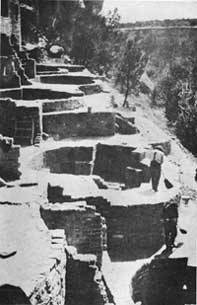
|
|
Plate 10. TOWER QUARTER, AFTER REPAIRING (left), TERRACES AT SOUTHERN
END, AFTER REPAIRING (right)
|
PLAZA QUARTER
The plaza quarter, as its name indicates, is a large
open space, the floor of which is formed mainly by the contiguous roofs
of the several kivas (K to O) that are sunk below it. The main entrance
to the village opens into this plaza at its northwestern corner, and on
the northern side it is continued into a court which connects with the
main street or alley of the cliff village. From its position, relations,
and other considerations, it is supposed that this quarter was an
important section of Cliff Palace and that here were held some of the
large open-air gatherings of the inhabitants of the place; here also no
doubt were celebrated the sacred dances which we have every reason to
believe were at times performed by the former inhabitants. The roof
levels of kivas H and I did not contribute to the size of the main
plaza, but show good evidence of later construction. Judging from the
number of fireplaces in this quarter there is reason to believe that
much cooking was done in this open space, in addition to its use for
ceremonial or other gatherings of the inhabitants.
OLD QUARTER
The section of Cliff Palace that has been designated
the old quarter (pls. 14, 15) lies between a line drawn from the main
entrance of the ruin to the rear of the cave and the extreme northern
end, culminating in a high castle-like cluster of rooms. It may well be
called one of the most important sections of Cliff Palace, containing,
as it does, the largest number of rooms, the most varied architecture,
and the best masonry. Its protected situation under the roof of the cave
is such that we may consider it and the adjoining plaza quarter the
earliest settled sections of the village. It contains all varieties of
inclosures known in cliff-dwellings kivas of two types, round rooms,
rectangular rooms, an alley or a street, and a court. The floor of the cave
on which the rooms are built is broadest at this point, which is one of
the best protected sites and the least accessible to enemies in the
whole building. It may be theoretically supposed that originally the
kiva quarter was an annex of this section and that some of the kivas in
this quarter may also have been owned and used by the clans which
founded Cliff Palace. The old quarter is divided into two parts, a
northern and a southern, the former being arbitrarily designated the
Speaker-chief's House. The "street" running approximately north and
south bisects the old quarter, making a front and a rear section.
NORTHERN QUARTER
This quarter (pl. 16) of Cliff Palace extends from
the high rocks on which the Speaker-chief's House is perched, in a
westerly direction, ending with a milling room and adjacent inclosures
92 to 94, situated west of kiva V. It includes three kivas; two, U and
V, being situated on the fourth terrace; and one, T, on the first
terrace. Kivas U and V are built on top of large rocks, the floor of
kiva V being excavated in solid rock. Much of this quarter, especially
the western end, is under the sky, and consequently without the
protection of the cave roof, on which account it was considerably
destroyed by rain water flowing over the canyon rim. The walls of this
quarter, especially where it joins the old quarter, exhibit fine
masonry, suggesting that it was inhabited by important clans.

Plate 11. TOWER QUARTER (photographed by
R. G. Fuller)
|
MASONRY
The walls of Cliff Palace present the finest masonry
known to any cliff-dwelling and among the best stonework in prehistoric
ruins north of Mexico. A majority of the stones used in the construction
were well dressed before laying and smoothed after they were set in the
wall. The joints are often broken, but it is rare to find intersecting
walls or corners bonded. Stones of approximately the same size are
employed, thereby making the courses, as a rule, level. Although
commonly the foundations are composed of the largest stones, this is not
an invariable rule, often larger stones being laid above smaller ones;
the latter, even when used for foundations, are sometimes set on edge.
As a rule, the walls are not plumb or straight. The custom of laying
stone foundations on wooden beams is shown in several instances,
especially in cases where it was necessary to bridge the intervals
between projecting rocks. The arch was unknown to the masons of Cliff
Palace; there are no pillars to support floors or roofs as in
Spruce-tree House. It is not rare, especially in the kivas, to find
instances of double or reenforced walls which may or may not be bonded
by connecting stones.
The masonry of the kivas as a rule is superior to
that of the secular rooms. The mortar employed in the construction is
hard; the joints are chinked with spalls, fragments of pottery, or clay
balls. The fact that much more mortar than was necessary was employed
resulted in weakening the walls. Several walls were laid without mortar;
in some of these the joints were pointed, in others not.a The
ancient builders did not always seek solid bases for foundations, but
built their walls in several instances on ashes or sand, evidently not
knowing when the foundations were laid that other stories would later be
constructed upon them.
aFragments of mortar from the walls and
floors, ground to powder, were used in the repair work.
In several sections of the ruin there are evidences
that old walls, apparently of houses formerly used, served in part as
walls for new buildings. There are also several instances of secondary
construction in which old entrances are walled up or even buried and old
passageways covered with new structures. Similar reconstruction is
common in Hopi pueblos, where it has led to enlargement of rooms and
other variations in form. Among the several examples of such secondary
building in Cliff Palace may be mentioned a long wall, evidently the
front of a large building, which serves as a rear wall of several rooms
arranged side by side. The obvious explanation of such a condition is
that the walls of the small rooms are of later construction.
As above mentioned the foundations of many walls are
of larger stones, and the masonry here is coarser than higher up, which
has led some authors to ascribe this fact as due to two epochs of
construction. But this conclusion does not appear to be wholly
justifiable, although there is evidence in many places that there has
been rebuilding over old walls and consequent modification in new
constructions, by which older walls have ceased to be necessary, a
condition not unlike that existing in several of the Hopi pueblos. In this
category may be included the several doors and windows that have been
filled in with new masonry or even concealed by new walls. From the
fragile character of certain foundations of high walls it would appear
that it was not the intention, when they were laid, to erect on them
walls more than one story high; the construction of higher stories upon
them was an afterthought. Evidences occur of repair of breaks in the
walls and corners by the aboriginal occupants, one of the most apparent
of which appears at the end of the court in the southern wall of room
59.
ADOBE BRICKS
The walls, as a rule, were made of stone; indeed it
is unusual to find adobe walls in cliff-dwellings of the Mesa Verde. In
prehistoric buildings in our Southwest, evidences that the ancients made
adobe bricks, sun-dried before laying, are very rare. Bricks made of
clay are set in the walls of the Speaker-chief's House and were found in
the fallen debris at its base. These bricks were made cubical in form
before laying, but there is nothing to prove that they were molded in
forms or frames, nor do they have a core of straw as in the case of the
adobes used in the construction of Inscription House in the Navaho
National Monument, Arizona.a The use of adobes in the construction
of cliff-house walls has not been previously mentioned,
although we find references to "lumps of clay" in the earliest historic
times among Pueblos. Thus the inhabitants of Tiguex, according to
Casteñeda, were acquainted with adobes. "They collect," says this
author, "great heaps of thyme and rushes and set them on fire; when the
mass is reduced to ashes and charcoal they cast a great quantity of
earth and water upon it and mix the whole together. They knead this
stuff into round lumps, which they learn to dry and use instead of
stone."
aSee Bulletin 50, Bureau of American
Ethnology.
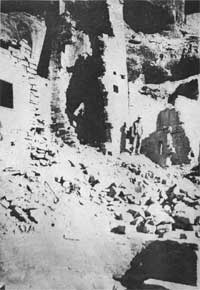
|

|
|
Plate 12. THE SQUARE TOWER, BEFORE AND AFTER REPAIRING
(photographed by R. G. Fuller)
|
Attention may be called to the fact that not only the
adobes found at Cliff Palace but also the mortar used in the
construction of the walls contain ashes and sometimes even small
fragments of charcoal. Clay or adobe plastered on osiers woven between
upright sticks, so common in the walls of cliff-dwellings in Canyon de
Chelly and in the ruins in the Navaho Monument, while not unknown in the
Mesa Verde, is an exceptional method of construction and was not
observed at Cliff Palace. The survivala of this method of
building a wall, if survival it be, may be seen in the deflector of kiva
K.
aIn at least one of the Oraibi kivas the
plastering of the wall is laid on sticks that form a kind of lathing.
Whether this is a survival of an older method of construction or is
traceable to European influence has not been determined, but it is
believed to be a survival of prehistoric wall construction.
PLASTERING
The walls of a number of rooms were coated with a
layer of plastering of sand or clay. This was found on the outside of
some walls, where it is generally worn, but it is best preserved on the
interior surfaces. Perhaps the most striking examples of plastering on
exterior walls occurs on the Speaker-chief's House, where the
smoothness of the finish is noteworthy.
From impressions of hands and fingers on this
plastering it is evident that it was laid on not with trowels but with
the hands, and as the impressions of hands are small the plasterers were
probably women or children. In several instances where the plastering is
broken several successive layers are seen, often in different colors,
sometimes separated by a thin black layer deposited by smoke. The color
of the plastering varies considerably, sometimes showing red, often
yellow or white, depending on the different colored sand or mud
employed.b The plastering not only varies in color but also in
thickness and in finish. In the most protected rooms of the cave practically
all the superficial plastering still remains on both the interior
and the exterior of the walls, but for the greater part it has been
washed from the surfaces and out of the joints in the outer buildings.
The mortar was evidently rubbed smooth with the hands, aided, perhaps,
with flat stones. The exterior of one or two rooms shows several coats
of plaster, and different parts of the same walls are of different
colors. Indistinct figures are scratched on several walls, but the
majority of these are too obscure to be traced or deciphered. The
plastering on the exterior and the interior of the same wall is often of
different color.
b The red color is derived from the red soil
common everywhere on the mesa. Yellow was obtained from disintegrated
rock, and white is a marl which is found at various places. The mortar
used by the ancient masons became harder, almost cement, when made of
marl mixed with adobe.
PAINTINGS AND ROCK MARKINGS
Figures are painted on the white plastering of the
third story of room 11 and on the lower border of the banquette of kiva
I, the former being the most elaborate mural paintings known in cliff
dwellings, showing several symbols which are reproduced on pottery. A
reversed symbolic rain-cloud figure, painted white, occurs on the
exterior of the low ledge house.a Mural paintings of unusual form
are found on the under side of the projecting rock forming part of the
floor of room 3, and there are scratches on the plastering of the wall
of kiva K. The latter figures were intended to represent animals, heads
of grotesque beings, possibly birds, and terraced designs symbolic of
rain clouds. As one or more of these symbols occur on pottery fragments,
there appears no doubt that both were made by the same people. Among
rock markings may also be mentioned shallow, concave grooves made by
rubbing harder stones, which can be seen on the cliffs in front of rooms
92 and 93 and in the court west of room 51.
aThis figure resembles closely that on the
outside walls of the third story of room 11 of Spruce-tree House. (see
pls. 4, 5, 6, Bulletin 41, Bureau of American Ethnology.)
Among the figures painted on whitewashed walls of
room 11 may be mentioned triangles, parallel red lines with dots, and a
square figure, in red, crossed by zigzags, recalling the designs on old
Navaho blankets.
The parallel lines are placed vertically and are not
unlike, save in color, those which the Hopi make with prayer meal on the
walls of their kivas, in certain ceremonies. But it is to be noted that
the Hopi markings are made horizontally instead of vertically, as at
Cliff Palace. The dots represented on the sides of some of these
parallel lines (room 11) are similar to those appearing on straight
lines or triangles in the decoration of Mesa Verde pottery. The
triangular figures still used by the Hopi in decorating the margins of
dados in their houses also occur on some of the Cliff-Palace walls, but
are placed in a reversed position. They are said to represent a
butterfly, a rain cloud, or a sex symbol. It is interesting to note in
passing that two or more triangles placed one above another appear
constantly in the same position in Moorish tile and stucco decorations,
but this, of course, is only a coincidence, as there is no evidence of a
cultural connection.
 |
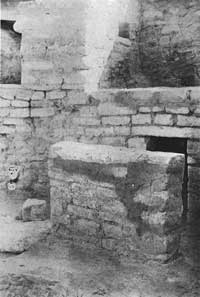
|
|
Plate 13. DETAILS OF CLIFF PALACE
(photographed by R. G. Fuller)
|
REFUSE HEAPS
Almost every Mesa Verde cliff-dwelling has an
unoccupied space back of the rooms,a as in the rear of rooms 28
to 40, which served as a depository for all kinds of rubbish. Here the
inhabitants of Cliff Palace also deposited certain of their dead, which
became mummified on account of the dryness of the air in the cave.
aIsolated cliff-dwellings are scattered
throughout the Southwest, but there are several areas, as the Mesa
Verde, in which they are concentrated. Among these clusters may be
mentioned the Canyon de Chelly the Navaho National Monument, the Red
Rocks area, and that of the upper Gila. One characteristic feature in
which the cliff-dwellings of the Mesa Verde differ from some others is
the independence of all of the upright walls from support of the sides
of the cliffs, in the cliff-houses of the Navaho Monument a large
majority of the houses have the rear wall of the cave as a wall of the
building; a few of the houses in Cliff Palace have the same, but the
largest number are entirely free from the cliff. This separation on all
sides is due largely to the geological structure of the rear of the
cavern in which the cliff-house stands.
There is also a vacant space between the rear of the
Speaker-chief's House and the cave wall, but this space was almost
entirely free of refuse. The amount of debris in the refuse heaps back
of the so-called plaza quarter lends weight to other evidence that this
is one of the oldest sections of Cliff Palace.
The accumulation of debris was so deep in these
places, and the difficulties of removal so great, that it was not
attempted. It had all been dug over by relic seekers who are said to
have found many specimens therein.b
bWorkmen could operate in these parts only by
tying sponges over their nostrils, so difficult was it to breathe on
account of the fine dust.
SECULAR ROOMS
The majority of the rooms in Cliff Palace were
devoted to secular purposes. These are of several types, and differ in
form, in position, and in function. Their form is either circular or
rectangular, or some modification of these two. As a rule, the secular
rooms lie deep under the cliffs, several extending as far back as the
rear of the cave. The front of Cliff Palace shows at least two tiers or
terraces of secular rooms, the roof of the lower one being level with
that of the floor of the tier above. The front walls of secular rooms
lower than the fourth terrace are as a rule destroyed, but the lateral
walls are evident, especially in the tower quarter. The passage from one
of these terraces to the room above was made by means of ladders or by
stone steps along the corners.
The following classification of secular rooms, based
on their function, maybe noted: (1) Living rooms; (2) milling rooms;
(3) storage rooms; (4) rooms of unknown function;c (5) towers;
(6) round rooms. It is difficult to distinguish in some instances to
which of the above classes some of the rooms belong. The secular houses
were probably owned by the oldest women of the clan, and the kivas were
the property of the men of their respective clans, but courts, plazas,
and pasageways were common property.
cPossibly some of these may have been used
sometimes for ceremonial purposes, or rather for the less important
rites.
ETHNOLOGY
The masonrya of all secular rooms is
practically identical and as a rule is inferior to that of kivas, their
walls varying in width and having a uniform thickness from foundation to
top. There are instances where the lower part projects somewhat beyond
the upper, from which it is separated by a ledge, but this feature is
not common. Minor features of architecture, as floors and roofs, doors
and windows, fireplaces, banks, and cubby-holes, some or all of which
may be absent, vary in form and in distribution according to the purpose
for which the room was intended. The few timbers that remain show that
the beams of the houses were probably cut with stone hatchets aided by
the use of fire. The labor of hauling these timbers and of stripping
them of their branches must have been great, considering the rude
appliances at hand. It would seem that the cliff-dwellers were not
ignorant of the use of the wedge with which to split logs, since the
surfaces of split sticks are always more or less fibrous, never smooth,
as would be expected if metal implements had been used. All
transportation was manual, without the assistance of beasts of burden or
of any but the rudest mechanical contrivances.
aProbably both men and women of one clan
worked together in the construction of houses, the men being the masons,
the women the plasterers. Each clan built its own rooms, and there were
no differentiated groups of mechanics in the community.
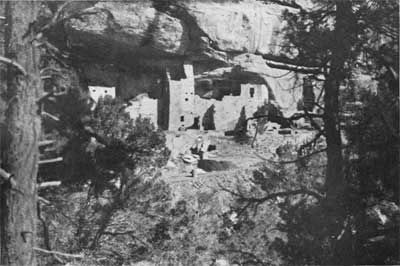
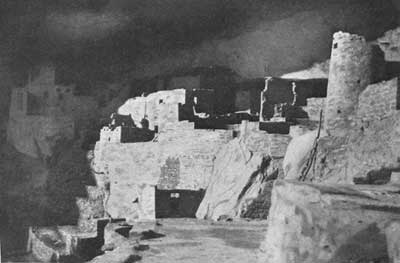
Plate 14. SQUARE TOWER, AFTER REPAIRING (top);
OLD QUARTER (bottom) (photographed by R. G. Fuller)
|
DOORS AND WINDOWS
There is difficulty in distinguishing doorways from
windows in cliff-dwellings, on which account they are here treated
together. Both are simple openings in the walls, the former as a rule
being larger than the latter. As door openings are regularly situated
high above the floor, there may have been ladders by which the doorways
of the second and third stories were reached. The rooms may have been
entered by means of balconies, evidences of which still remain. No
instance of a hatchway in the roof is now recognizable, although the
absence of side entrances in several rooms implies that there were roof
entrances, several good examples of which occur at Spruce-tree
House.
Doorways of Cliff Palace have two forms, rectangular
and T-shaped the latter generally opening on the second story or in such
a position that they were approached by ladders or notched logs. The
theory that these doorways were constructed larger at the top than at
the bottom so that persons with packs on their backs might pass through
them more readily is not wholly satisfactory, nor does the theory that
the notch at the lower rim served to keep the ladder from slipping
wholly commend itself. No satisfactory explanation of the form of the
T-shaped doorway has been yet determined. Generally the tops of both
doorways and windows are narrower than the bottoms, the sides being
slightly inclined; but the lower part is rarely narrower than the top.
Sills sometimes project slightly, and evidences occur that the sides
as well as the upper part of the window and doorway were made of adobe,
now no longer in place. The jambs also were probably of clay, and the
doors, made of slabs of stone, neatly fitted the orifices.
The prevailing storms in winter at Cliff Palace sweep
up the canyon from the southwest, but there does not seem to have been
a systematic effort to avoid the cold by placing doors and windows on
the opposite side of the building; the openings, for instance, of the
Speaker-chief's House face this direction and are open to storms of snow
and rain. Many of the openings never had doors and windows, but were
probably closed with sticks tied together, or with matting.a
Certain windows were half closed, probably to temper the winter blasts.
The sills of doors were commonly placed a foot or more above the
floor;b transoms above the door opening and peepholes at the side
are not common in Cliff Palace. In some cases a stepping stone projects
from the wall below the door opening to facilitate entrance, in others a
foot hole is found in the same relative place.
aSome of the doorways were filled with rude
masonry; evidently the rooms were thus closed in some instances before
the buildings were deserted.
bThe placing of the sill at a level with the
floor is a modern innovation at Walpi. The oldest houses still have it
elevated, as in Cliff Palace. In some of the cliff-houses of the Navaho
Monument sills and floor levels are continuous.
As the jambs, sills, and lintels were built hard and
fast in the mortar, evidently both door openings and windows were
constructed when the corresponding wall was built. The jambs in some
instances and the lintels in others are of split sticks, the surfaces of
which are fibrous and were evidently not split by means of iron
implements. There is evidence that the size of the door openings was
sometimes reduced by a ridge of mortar which was arched above, as at
Spruce-tree House, the intention being to make in this way a jamb to
hold in place the stone door. There are no round windows of large size,
but both doors and windows are quadrilateral in shape; the small
circular openings in some of the walls may have served for
lookouts.
FLOORS AND ROOFS
Not a single entire roof remained in Cliff Palace,
and only one or two rooms retained remnants of rafters. It would seem,
however, from the position of the holes in the walls into which the
rafters once extended that they were constructed like those of
Spruce-tree House, a good example of which is shown in plate 9 of the
report on that ruin. The floors seem to have been formed of clay
hardened by tramping, but there is no evidence of paving with flat
stones. The hardened adobe is sometimes laid on sticks without bark and
stamped down. Although no instance of extensive rock cutting of the
floor was observed in secular rooms, this is a common feature of kiva
floors. Floors were generally level, but in some instances, when rock
was encountered, the surface was raised in part above the other level.
The majority of the floors had been dug into for buried specimens
before the repair work was begun, but here and there fragments of floors
were still intact, showing their former level. Banquettes or ledges
around the walls are rare. In a few instances the unplastered roof of
the cave served as the roof of the highest rooms.
FIREPLACES
Many fireplaces still remain in rooms, but the
majority are found in convenient corners of the plazas.a The most
common situation is in an angle formed by two walls, in which case the
fire-pit is generally rimmed with a slightly elevated rounded ridge of
adobe. In room 84 there is a fireplace in the middle of the floor. At
one side of this depression there extends a supplementary groove in the
floor, rimmed with stone, the use of which is not known. Although
fireplaces are ordinarily half round, a square one occurs in the
northwestern corner of room 81. All the fireplaces contained wood ashes,
sometimes packed hard; but no cinders, large fragments of charcoal,
or coal ashes were evident. The sides of the walls above the fireplaces
are generally blackened with smoke.
aSmoke on the walls of certain second and
third stories shows that fireplaces were not restricted to the ground
floor.
The fire-holes of the kivas, being specially
constructed, are different in shape from those in secular houses. While
the cooking fire-pits are generally shallow, kiva fire-holes a foot deep
are not exceptional, and several are much deeper. The fire was kindled
in the kiva not so much for heating the room as for lighting it, there
being no windows for that purpose. Certain kinds of fuel were probably
prescribed, but logs were not burned in kivas on account of the heat. No
evidences of smoke-hoods or chimneys have been found in any of the Cliff
Palace rooms. The walls of many kivas showed blackening by soot or
smoke.

Plate 15. SPEAKER-CHIEF'S HOUSE, AFTER REPAIRING
(photographed by R. G. Fuller)
|
LIVING ROOMS
It is difficult to distinguish rooms in which the
inhabitants lived from others used by them for storage and other
purposes, since most of their work, as cooking, pottery making, and like
domestic operations, was conducted either on the house-tops or in the
plazas. Under living rooms are included the women's rooms,a or
those in which centered the family life; and, in a general way, we may
suppose the large rooms and those with banquettes were sleeping rooms.
The popular misconception that the cliff-dwellers were of small stature
has undoubtedly arisen from the diminutive size of all the secular
rooms, but it must be remembered that the life of the cliff-dwellers
was really an out-of-door one, the roof of the cave affording the
necessary protection.
aAmong the Hopi the oldest woman, as a clan
representative, owns the living rooms, but kivas are the property of the
men, the kiva chief of certain fraternities being the direct descendant
of the clan chief of the ceremony when limited to his clan.
MILLING ROOMS
There are several rooms in Cliff Palace which appear
to have been given up solely to the operation of grinding corn. The
mills are box-like structures, constructed of slabs of stone set on
edge, each containing a slanting stone called a metate, from which the
mill is called by the Hopi the metataki, or" metate house." The
following description of a metataki in pueblos seen by Castañeda in
1540 applies, in a general way, to the small milling troughs in Cliff
Palace:
One room is appointed for culinary purposes, another
for the grinding of corn; the latter is isolated [not so in Cliff
Palace] and contains an oven and three stones [one, two, three, or four
in Cliff Palace], cemented finely together. Three women sit [kneel]
before these stones; the first crushes the corn, the second grinds it,
and the third reduces it quite to a powder.
In grinding corn, which was generally the work of the
girls or young women, the grinder knelt before the metataki and used a
flat stone, which was rubbed back and forth on the metate. The corn meal
thus ground fell into a squarish depression, made of smooth stones, at
the lower end of the metate. Commonly the corners of this receptacle for
the meal that had been ground were filled in with clay, and on each side
of the metate were inserted fragments of pottery, which rounded the
corners and made it easier to brush the meal into a heap. In room 92,
where there are four metates, occupying almost the whole milling room,
there are upright stones on the side of the wall, back of the place
where the women knelt, against which they braced their feet.
Most of the grinding boxes were destroyed, but those
in the Speaker-chief's house and others west of kiva V, especially the
latter, were still in good condition, the metates being in place.
Evidences of former metatakis were apparent in the floor of several
other rooms, as in a room back of kiva K. It is evident from the number
of metates found in Cliff Palace that several milling rooms, not now
recognizable, formerly existed, and it is probable that every large
clan had its own milling room, with one or more metatakis, according to
necessity. Although many metates without metatakis occur in Cliff
Palace, that in itself is not evidence that they were moved from place
to place by the inhabitants. These milling rooms were apparently
roofed, low, and one-storied, possibly in some instances open on top,
but generally had a small peephole or window for the entrance of light
or for permitting the grinders to see passers-by.
GRANARIES
Under the general name of granaries are included
storage rooms, some of which are situated below living rooms.a
Here corn for consumption was stacked, and if we may follow Hopi customs
in our interpretation of cliff-dwellers' habits, the people of Cliff
Palace no doubt had a supply sufficient to prevent famine by tiding over
a failure of crops for two or more years. Many of these chambers were
without doorways or windows; they were not limited to storage of corn,
but served for the preservation of any food products or valuable cult
paraphernalia. Each clan no doubt observed more or less secrecy in the
amount of corn it kept for future use, and on that account the storage
rooms were ordinarily hidden from view.
aGenetically the room for storage of property
was of earliest construction. This custom, which was necessary among
agriculturists whose food supply was bulky, may have led to the choice
of caves, natural or artificial, for habitation.
The droppings of chipmunks and other rodents show
that these commensals were numerous, and their presence made necessary
the building of storage rooms in such manner that they would be proof
against the ravages of such animals. The three cists constructed of
stone slabs placed vertically, situated back of the Speaker-chief's
House, sometimes called "eagle houses," were probably storage bins; in
support of this hypothesis may be mentioned the fact that the cobs,
tassels, and leaves of corn are said to have been abundant in them when
Cliff Palace was first visited by white men.
Although eagle bones are found in the refuse in the
unoccupied part of the cave back of the houses, their abundance does not
necessarily prove that eagles were confined in them by the inhabitants
of Cliff Palace. Perhaps the eagle nests in the canyon were owned by
different clans and were visited yearly or whenever feathers were
needed, and the dead eagles were probably buried ceremonially in these
places, which therefore may be called eagle cemeteries, as among the
Hopi.b
bSee Property Rights in Eagles, American
Anthropologist, vol. II, pp. 690-707, 1907.

Plate 16. NORTHERN PART, FROM THE SPEAKER-CHIEF'S HOUSE TO THE WESTERN
END
|
CREMATORIES
As is well known to students of the Southwest, the
tribes of Indians dwelling along the lower Colorado river disposed of
their dead by cremation, and evidences of burning the dead are found
among all the ruins along the Gila and Salt rivers in southern Arizona.
The custom was also practiced in the San Pedro and Salt River valleys,
and along other tributaries of the Gila river. Castañeda (1540) says
that the inhabitants of Cibola, identified with Zuñi, burned their dead,
but no indication of this practice is now found among existing Pueblos.
The ancient Pueblo inhabitants of the Little Colorado, so far as known,
did not burn their dead, and no record has been made of the practice
among their descendants, the Hopi and Zuñi.
In his excellent work on the ruins of the Mesa Verde,
Baron Nordenskiöld speaks of calcined human bones being found in a stone
cist at Step House, and Mr. Wetherill is referred to as having observed
evidence of cremation elsewhere among the Mesa Verde cliff-dwellings.
There can be no doubt from the observations made in the refuse heaps at
Cliff Palace that the inhabitants of this village not only burned their
dead but there was a special room in the depths of the cave which was
set aside for that purpose.a One of these rooms, situated at the
northern end of the refuse heap, was excavated in the progress of the
work and found to contain bushels of very fine phosphate ashes, mixed
with fragments of bones, some of which are well enough preserved to
enable their identification as human. Accompanying these calcined bones
were various mortuary objects not unlike those occurring in graves where
the dead were not cremated. The existence of great quantities of ashes,
largely containing phosphates, apparently derived from the burned
bones, forming much of the refuse, and the densely smoke-blackened roof
of the cave above them, are interpreted to indicate that the dead were
cremated in the cave back of the houses.
aWhile only one place where bodies were burned
was found in Cliff Palace, several such places were found on top of the
mesa. Evidences of similar inclosures occur at Spruce-tree House and at
Step House.
In addition to these burning places, or crematories,
in the rear of the buildings of Cliff Palace, there is good evidence of
the same practice on the mesa top. Here and there, especially in the
neighborhood of the clearings where the cliff-dwellers formerly had
their farms, are round stone inclosures, oftentimes several feet deep,
in which occur great quantities of bone ashes, fragments of pottery, and
some stone objects. The surface of the stones composing these inclosures
shows the marks of intense fire, which, taken in connection with the
existence of fragments of human bones more or less burned, indicate that
the dead were cremated in these inclosures. It is not clear, however,
that the dead were not interred before cremation, and there is reason
for believing that the bodies were dried before they were committed to
the flames. The mortuary offerings, especially pottery, seem to have
been placed in the burning places after the heat had subsided, for
beautiful jars showing no action of fire were found in some of these
inclosures. The existence of cremation among the cliff-dwellers is
offered as an explanation of the great scarcity of skeletons in their
neighborhood. When it is remembered that Cliff Palace must have had a
population of several hundred, judging from the number of the buildings,
and was inhabited for several generations, it otherwise would be
strange that so few skeletons were found. It would appear that the
chiefs or the priestly class were buried either in the ground or in the
floors of the rooms, which were afterward sealed, whereas the bodies of
the poorer class, or the people generally, were cremated. The former
existence of Pueblo peoples who buried their dead in the region between
the Gila valley and Mesa Verde where the dead were cremated is a
significant fact, but further observations are necessary before it can
be interpreted. It may be that in ancient times all the sedentary tribes
practiced cremation, and that the region in question was settled after
this custom had been abandoned.
LEDGE ROOMS
In a shallow crevice in the roof of the cave on a
higher level than the roofs of the tallest houses there is a long wall,
the front of inclosures that may be called "ledge rooms."a Some
of these rooms have plastered walls, others are roughly laid; the latter
form one side of a court and served to shield those passing from one
room to another. On this outer wall, about midway, there is painted in
white an inverted terrace figure, which may represent a rain cloud.
Attention should be called to the resemblance in form and position of
this figure to that on an outside wall overlooking plaza C of
Spruce-tree House. This series of ledge rooms was probably entered from
the roof of a building in front, and the opening or doorway above room
66 served as such an entrance, according to several stockmen who
visited Cliff Palace in earlier days.
aThis type of building is believed to be the
oldest in those sections of the Southwest where cliff habitations
occur.
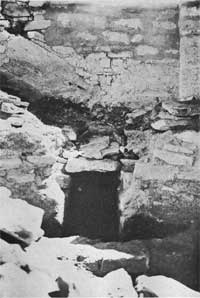
|
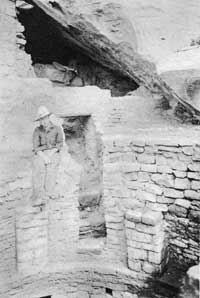
|
|
Plate 17. DETAILS OF KIVA A (aTunnel to Kiva B (left),
bPassageway with steps to room 3 (right), photographed by R. G. Fuller)
|
|

|

